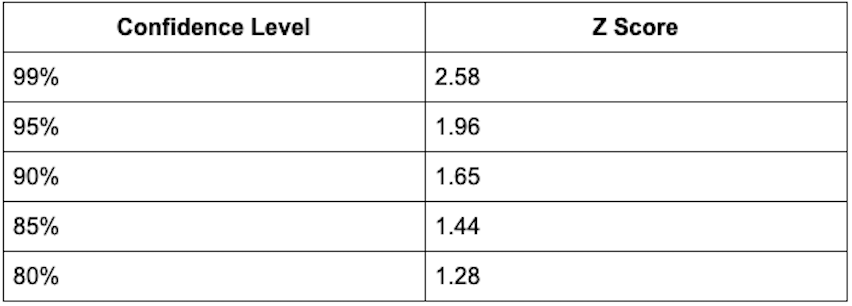
Data runs the business world these days. It’s great to always use data to back everything from major business decisions to website tweaks. But data is only as good as the survey that pumped it out. If you put bad information into your survey, your data isn’t reliable to base your business decisions on. How do you prevent this from happening? After all, you don’t want to have bad data at the helm of your decisions.
One way researchers try to ensure their information is reliable is to use random sampling, specifically systematic sampling. By adding the element of randomness, results are more representative of the population you’re trying to study.
Consider a retail business that wants to understand customer satisfaction with recent in-store experiences to pinpoint specific aspects needing attention, such as staff friendliness, store cleanliness, and product availability. They can use systematic sampling to gather feedback from every 15th customer that enters the store until they reach the desired sample size. Since these customers were chosen at random, the results can be used to represent and measure the entire customer base.
What Is Systematic Sampling?
Systematic sampling is a type of probability sampling that uses a specific interval to select participants. Probability sampling is when every member of the population (the entire group you want to study) has an equal chance of being selected. It’s the foundation of good data collection. However with systematic sampling, you choose a regular interval and select your participants that way.
Imagine you have a list of 100 people in your population, and you want to use systematic sampling to select your sample. You decide on an interval of five. The best way to use systematic sampling is to choose a random place to start on your list. Maybe you start at the second name listed. From there, you would choose every fifth name to be a participant. That’s systematic sampling.
The key features of systematic sampling are that it’s probability-based and that there’s a specific number interval used to select your sample.
Types of Systematic Sampling
The basics of systematic sampling are the same, but there are a few different ways you can perform a systematic sample. The three types of systematic sampling are systematic random sampling, circular systematic sampling, and linear systematic sampling.
Systematic Random Sampling
Systematic random sampling is the classic way to use systematic sampling. It involves choosing a particular interval that is used to randomly select participants. But how do researchers choose effective intervals? Most use their population size and figure out how many they want in a sample. For example, if you have 100 people in your population, and you know you want to survey 20 of them, you know your interval will be 5.
Circular Systematic Sampling
Circular systematic sampling is most useful if you know you want to sample your entire population, but you still want the element of randomness in your sampling methods. Circular systematic sampling works the same as classic systematic sampling at first. But instead of stopping selection after you reach the end of the population list, you start again and keep selecting using your numeric interval until you’ve sampled everyone in your population.
For example, let’s return to our list of 100 people. You choose the interval of 5 for your sampling and randomly select starting on the fourth name. You sample every fourth name until you reach the end of the list. But instead of stopping there, circular systematic sampling has you keep sampling every fourth name until you’ve gone through the whole list. It’s a great way to continue to select randomly while sampling your whole population. Circular systematic sampling isn’t a great choice if you have a very large population, and you only need a small sample and a way to whittle the list down.
Linear Systematic Sampling
Linear systematic sampling is another variation, but it’s different from circular sampling. Linear systematic sampling doesn’t repeat and continues until the whole population is sampled. Instead, linear sampling uses a form of skip logic to select. Skip logic is something you might use to send participants in a survey to a different spot in the survey based on their answers. The researcher uses skip logic to select where to start on the survey and the interval to use. If you think of the list of 100 population members, here you would use skip logic to determine where the sampling starts and who is chosen, and it doesn’t repeat at the end.
When Is Systematic Sampling Used?
When do researchers choose to use systematic sampling? Systematic sampling provides a unique way to use random sampling without having to have a lot of details on your population or on a tight budget or timeline. These are some of the scenarios when systematic sampling is commonly used:
- Budget or timing restrictions: If you have an upcoming deadline or a small budget for sampling, systematic sampling is simple to implement and quick for picking a sample under a time crunch. You can very quickly number a population list and randomly select an interval and starting point and choose participants quickly. This same process also requires few resources, and you don’t have to know much about your population to get started with systematic sampling.
- Simple outcomes: Systematic sampling is a simple way to choose a sample, so it’s best when used when the outcomes are simple. A complicated survey isn’t the place for a simple systematic sample.
- Absence of data patterns: Systematic sampling is used when the data aren’t arranged or have an obvious pattern or opportunity for data manipulation. That could lead to problems. But without that, systematic sampling is a great choice.
How to Conduct Systematic Sampling
Performing systematic sampling involves a series of steps to ensure randomness and representation. Here’s a step-by-step guide:
1. Define Your Population
Clearly identify the entire population you want to study. This could be a list of customers, employees, or any group relevant to your research.
If you do not have a list readily available, you can go into the field to survey the intended group. Take the retail example from earlier, an employee at the register could ask every 15th customer “Did you find everything you were looking for today?” This way of surveying customers mirrors the randomization process that a formal population list would give you.
2. Determine Your Sample Size
Decide how many participants you want in your sample. This should be a reasonable fraction of your population and is often based on your research objectives and available resources.
3. Calculate the Sampling Interval
Divide the total population size by the desired sample size to determine the sampling interval. For example, if you have 100 people and want a sample of 20, your interval is 5 (100/20).
4. Randomly Choose a Starting Point
Begin at a randomly selected point in your population. This could involve using a random number generator or another method to ensure true randomness.
5. Select Participants Systematically
Starting from your randomly chosen point, select every nth individual, where n is the sampling interval. For instance, if your interval is 5, select every fifth person until you reach your desired sample size.
6. Avoid Biases
Ensure your list is randomly ordered at the outset to prevent bias. If there’s a discernible pattern in your population list, it could compromise the randomness of your sample.
7. Record Your Methodology
Document the steps you took in selecting your sample. This transparency aids in replicability and allows others to assess the validity of your sampling method.
Examples of Systematic Sampling
Let’s explore a couple of real-world examples to illustrate how systematic sampling works:
Example 1: Customer Satisfaction Surveys
Imagine you run a business with a customer database of 500 clients, and you want to gauge overall satisfaction. You decide to systematically sample 100 customers. Here’s how:
- Define Population: Your population is the entire customer database.
- Determine Sample Size: You decide on a sample size of 100 customers.
- Calculate Sampling Interval: Divide 500 (total customers) by 100 (desired sample size) to get an interval of 5.
- Random Starting Point: Choose a random starting point in your customer list.
- Select Participants: Systematically survey every 5th customer from your starting point until you reach 100 responses.
Example 2: Employee Training Evaluation
In a company with 200 employees, the HR department wants to assess the effectiveness of a recent training program. They opt for systematic sampling:
- Define Population: The population is all 200 employees who underwent the training.
- Determine Sample Size: The HR team decides on a sample size of 40 employees.
- Calculate Sampling Interval: Divide 200 (total employees) by 40 (desired sample size) to get an interval of 5.
- Random Starting Point: Choose a random starting point in the list of trained employees.
- Select Participants: Systematically evaluate the performance of every 5th employee until they reach 40 responses.
These examples demonstrate how systematic sampling can be applied in different scenarios, providing a structured and representative approach to data collection.
Common Mistakes in Implementing Systematic Sampling
While systematic sampling is a relatively straightforward method, certain pitfalls can compromise the integrity of your results. Avoiding these common mistakes is essential to ensure the accuracy and representativeness of your sample.
1. Non-Randomized Starting Point:
- Mistake: Choosing a starting point that is not truly random can introduce bias. If the starting point follows a pattern or is influenced by external factors, the entire sample may not be representative of the population.
- Solution: Use a randomization method, such as a random number generator, to select the initial participant. This helps eliminate any unintentional biases at the starting point.
2. Incorrect Calculation of Sampling Interval
- Mistake: Calculating the sampling interval incorrectly can lead to an unrepresentative sample. Errors in determining the interval may result in oversampling or undersampling certain segments of the population.
- Solution: Double-check your calculations to ensure the sampling interval is accurate. Verify that it aligns with your desired sample size and the total population.
3. Failure to Randomly Order the Population List
- Mistake: Neglecting to randomize the order of the population list before implementing systematic sampling can introduce systematic biases. If there is an existing order or pattern, it may carry through to the sample.
- Solution: Randomly order the population list before starting the systematic sampling process. This helps ensure that each individual has an equal chance of being selected.
4. Misinterpretation of Results
- Mistake: Misinterpreting the results or drawing conclusions beyond the scope of the study can lead to inaccurate insights. Failing to recognize the limitations of systematic sampling may result in unwarranted generalizations.
- Solution: Clearly define the objectives of your study and acknowledge the limitations of systematic sampling. Present the results with a clear understanding of what the sample can and cannot represent.
5. Ignoring Population Changes
- Mistake: Assuming that the population remains static throughout the study without accounting for potential changes can lead to inaccurate results. Population dynamics, such as growth or decline, should be considered.
- Solution: Periodically reassess the population characteristics and adjust the sampling process if there are significant changes. This ensures that your sample remains representative of the current population.
By being aware of these common mistakes and taking proactive measures to address them, researchers can enhance the reliability and validity of their systematic sampling approach. Regular checks, documentation, and attention to randomization principles are key to a successful implementation.
Advantages of Systematic Sampling
Systematic sampling offers several advantages that make it a preferred choice in certain situations:
- Simple to understand: Not every method of sampling randomly is easy for researchers to understand—especially not with an extensive background in statistics. Systematic sampling is easy to grasp and easy to get started with.
- Easy to implement: Nothing’s worse than having extremely difficult sampling requirements to grapple with that take forever to actually get started. Systematic sampling avoids that. Instead, it’s easy to get started quickly.
- Organized method of sampling: Organization with your data is key to making analysis simple and doable down the road. Systematic sampling is exactly what it sounds like: systematic. And systematic is organized and can help you keep track of what’s going on.
- Low risk for bias or contamination when done well: Data contamination and bias can leave you with bad results and bad data to base your decisions on. Systematic sampling can be a way to combat that. So long as the population list can be ordered randomly, there’s a low risk for bias or data contamination when you use this sampling method.
Disadvantages of Systematic Sampling
While systematic sampling has its advantages, it also comes with certain limitations and challenges. Researchers have to plan for and make sure to avoid these when using systematic sampling:
- Risk of bias: While there’s a low risk of bias, there’s still a risk that has to be managed. The list of population members must be ordered randomly, or there’s sampling bias. That’s easy when you have a list of names and can order that randomly but could be complicated for other populations.
- Risk of data manipulation: When you use systematic sampling, you’re setting up a system to use. There’s a risk that researchers might set up a system to intentionally give them the results they want, introducing a world of problems into their data.
- Requires population size: The other risks can be controlled for, but this disadvantage is an inherent one. To effectively use systematic sampling, you have to be able to number your population. That means you have to know your population size exactly before you can sample. It might be easy when you’re sampling the employees at your company, but it might be more difficult when you have a potentially massive population that you aren’t sure what it entails.
Maximize the Potential of Systematic Sampling with InMoment
Overall, systematic sampling is a form of probability sampling and can be incredibly valuable on a tight timeline or budget with simple populations. The key is to make sure you’re using the right sampling method for your surveys. InMoment integrated CX approach gives you the power to combine data from multiple sources and discover value insights that drive better business decisions. Whether your sample size is in the hundreds or millions, the XI Platform can be changed to fit your business needs and help you make the most of your data—from sampling methods to analysis. Schedule a demo to see how InMoment can help you!


